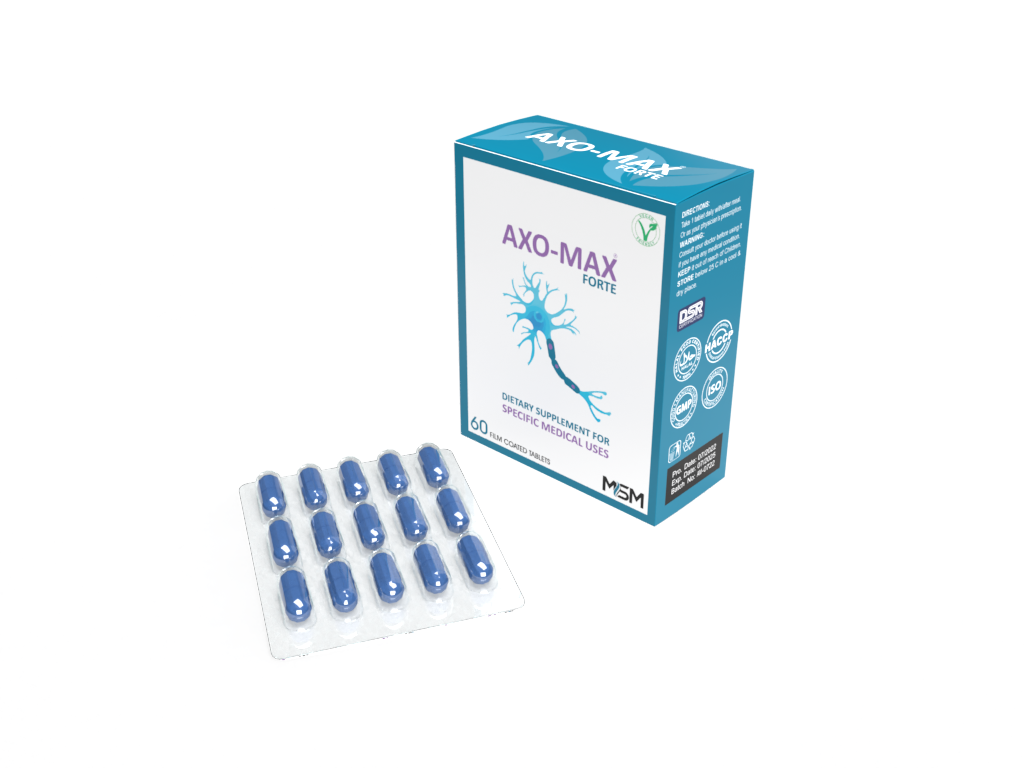INDICATIONS:
Alpha-lipoic acid: is used for treatment of many neurological disorders such as diabetic polyneuropathy, multiple scalerosis and protect peripheral
nerve from ischemia.
It is help lower blood suger levels.
Benfotiamine B1: It is used to treat diabetic neuropathy. it has signification improvment demonstrated in pain and vibration sensation as well as
nerve correlation velocity. (Benfotiamine is a lab-created version of thiamine B1).
Methylfolate: shows great potential in repairing nervous system injury because of its neurotrophic effects. methylfolate, a derivative of
water-soluble vitamins, plays a key role in the growth, differentiation and regeneration of the central nervous system.
Vitamin B6: is known for helping to maintain the cover of the body’s nerve endings.
Vitamin B12: In the nervous system, vitamin B12- helps produce a substance called myelin. Myelin is a protective coating that shields the nerves
and helps them transmit sensations. People who are vitamin B12- deficient may not produce enough myelin to coat their nerves. Without this
coating, nerves can become damaged.
Cytidine-5-Monophosphate (CMP): Cytidine monophosphate, also known as 5′-cytidylic acid or simply cytidylate, and abbreviated CMP, is a
nucleotide that is used as a monomer in RNA. It is an ester of phosphoric acid with the nucleoside cytidine. CMP consists of the phosphate group,
the pentose sugar ribose, and the nucleobase cytosine; hence, a ribonucleoside monophosphate. As a substituent it takes the form of the prefix
cytidylyl-CMP can be phosphorylated to cytidine diphosphate by the enzyme CMP kinase, with adenosine triphosphate or guanosine triphosphate
donating the phosphate group. Since cytidine triphosphate is generated by amination of uridine triphosphate, the main source of CMP is from RNA
being decomposed by RNAse. Cytidine -‘5monophosphate (CMP) is used as a substrate of uridine monophosphate (UMP)/cytidine monophosphate
(CMP) kinase (EC 4.4.2.7) to form CDP which upon phosphorylation to CTP supports DNA and RNA biosynthesis. It helps in memory loss due to
aging, improve vision in people with glaucoma, and help with recovery in stroke patients. It is also used for Alzheimer disease, Parkinson disease,
bipolar disorder, lazy eye, and other conditions of the brain.
Uridine-5-Triphosphate (UMP): Uridine-‘5-triphosphate (UTP) is a pyrimidine nucleoside triphosphate, consisting of the organic base uracil linked
to the ‘1 carbon of the ribose sugar, and esterified with tri-phosphoric acid at the ‘5 position. Its main role is as substrate for the synthesis of RNA
during transcription. UTP is the precursor for the production of CTP via the help of CTP Synthetase. UTP can be biosynthesized from UDP by
Nucleoside Diphosphate Kinase after using phosphate group from ATP. UDP + ATP UTP + ADP; both UTP and ATP are energetically equal. The
homologue in DNA is thymidine triphosphate (TTP or dTTP). UTP also has a deoxyribose form (dUTP). UTP also has the role of a source of energy
or an activator of substrates in metabolic reactions, like that of ATP, but more specific. When UTP activates a substrate (like Glucose-1-phosphate),
UDP-glucose is formed and inorganic phosphate is released. UDP-glucose enters the synthesis of glycogen. UTP is used in the metabolism of
galactose, where the activated form UDP-galactose is converted to UDP-glucose. UDP-glucuronate is used to conjugate bilirubin to a more
water-soluble bilirubin diglucuronide. UTP is also used to activate amino sugars like Glucosamine-1-phosphate to UDP-glucosamine, and
N-acetyl-glucosamine-1-phosphate to UDP-N-acetylglucosamine. UTP also has roles in mediating responses by extracellular binding to the P2Y
receptors of cells. UTP and its derivatives are still being investigated for their applications in human medicine. It also helps in memory loss due to
aging, improve vision in people with glaucoma, and help with recovery in stroke patients. It is also used for Alzheimer disease, Parkinson disease,
bipolar disorder, lazy eye, and other conditions of the brain
DIRECTIONS:
Take 1 tablet daily with/after meal. Or as your physician’s prescription.
Do not take more than the recommended daily dose.
SIDE EFFECTS:
If you take Axo-Max Forte as directed by the manufacturer, then you should not experience any unwanted side effects. However, if you do take
more of these Tablets than you should, seek medical advice right away.
IMPORTANT INFORMATIONS:
This product is a medicine; make sure to speak to your doctor or pharmacist before taking this product if you have an underlying medical problem or
are taking any other medicine or complementary therapy.
If your symptoms get worse or continue after taking this product, contact us or your doctor. If you are pregnant, trying to become pregnant, or
breastfeeding, speak to your doctor or pharmacist before taking this product.
If you suffer from any allergies, ask your doctor or pharmacist if this medicine is right for you.
– Store all medicines out of sight and reach of children.
– Store in a cool, dry place which is below 25 C.
– Store in original packaging and do not use if the expiry date printed on the packaging has passed.
– Please read the included leaflet carefully before using this product.






Reviews
There are no reviews yet.